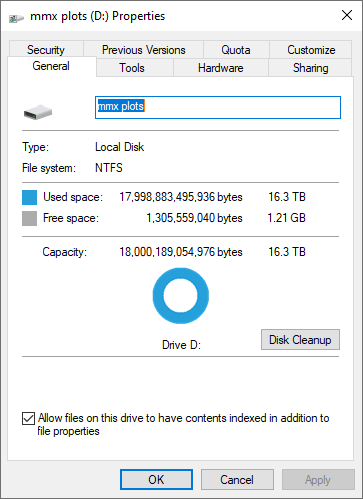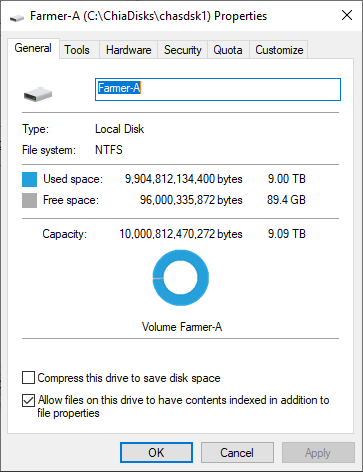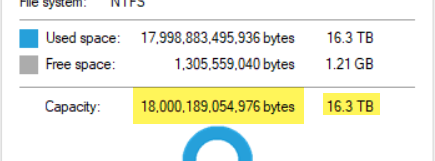I know this is a simple question, but I’m a simple person. When I format a 16TB Harddrive in windows it says available space of something like 14.5 TB is there a way to allow me to format it so I have more space available? Using a different format or program?
Thanks
Seagate has a writeup that explains it way better than I ever could. It comes down to the operating system reporting space in binary instead of decimal Why does my hard drive report less capacity than indicated on the drive's label? | Support Seagate US
Also Chia threw a wrench in the cogs by using the TiB notation (which is ‘more correct’ to be fair) that isn’t used by everyone https://www.cgdirector.com/tib-vs-tb/ instead of saying ‘screw it’ and just calling the space TB too, so that didn’t help lol.
Simple, sorry but no. My 18TB drives after formatting are 16.3TB


here a couple examples of an 18TB and 10TB disk.
In IT-terms, on a hardware level you calculate everything in binary format.
That means that you are able to calculate with numbers of x to the power of 2.
Visualized, for reach added bit, you can double the maximum number:
1 Bit: Max 2 (0&1)
2 Bit Max 4
3 bit - 8
…
8 bit 256
9 bit 512
10 bit 1024
What does that mean?
With 10 bits, you can store numbers up to 1024 If you were to calculate with 1000 as maximum instead, you waste valuable space (2.4% to be precise)
IT Technicians did not want to loose any space (especially in the old days where space was very, very expensive), so it makes sense to use the number 1024 for calculations. This is basically the IT Standard and how Computers calculate internally. Every operating system i came around (including windows and linux) denote this way.
Hard drive manufacturers how ever used the dubious practice to denote in 1000 (gigabyte) instead of 1024 (gibibyte) (which is basically it-standard on a hardware level)
They calculate that 1000 MB are 1 GB whereas IT Technicians calculate that 1024 MB are 1GB
Obviously, they did so, that they can write a larger capacity on the drive. DDR-RAM manufacturers instead use the correct 1024 calculation so that if you buy 16 gb of ram, you have 16 gb of ram.
For every 1000 factor increase, you loose an additional 2.4%. So the larger the drives, the worse it gets. This is where your ~10% loss comes from:
(byte → -2.4% kb → -2.4% mb → -2.4% gb → -2.4% tb)
In drhicoms screenshot, this becomes apparent, if you look at the actual drive capacity:

It is kind of like the car manufacturers who tell you the car uses 2.4L of fuel only but it uses 4 in reality.
That much to the marketing.
HDD Manufacturers show you some marketing BS whereas windows shows you your actual capacity of the drive (as if you drive to the gas station and all of a sudden notice your car uses way more)
Hard drives manufacturers even give them selves away, as the harddrives them selves internally calculate with binary (1024) notation. Guess how large one block on a harddrive usually is:
Each sector stores a fixed amount of user-accessible data, traditionally 512 bytes for hard disk drives (HDDs) and 2048 bytes for CD-ROMs and DVD-ROMs. Newer HDDs use 4096-byte (4 KiB) sectors, which are known as the Advanced Format (AF).
→ They know it very well and even calculate like that internally (which makes sense) but then claim 1000 notation would be the correct one
In linux, you can remove additional reserved headers for the drive freeing ~5%.
The only worse are network providers, denoting in 1GB data transfer. But what they mean is 1 Gigabit
(1 byte is 8 bit) so 1 GiB connection is a 128 MB/s actually
as a sidenote, I think chia actually calculates with 1000 notation for that reason so that if you buy a 16 tb harddrive, chia will show you 16 tb of plots in the end, but that is just poked into the blue, i havent actually tested it (as it does not matter for the final income)
Thanks everyone. I figured this was the case but just tryi g to see if tgere was a way to get a little more space for farming. I appreciate the help and resources.
if you want to get the utmost of your drive, use linux, format it as ex4 without any partitions on it.
use the command tune2fs -m 0 {device_path} to free up some space (~5%) which is normally reserved
Thanks. Im not a linux person but ive been thi king about outting it on an old laptop to play with it.
better think twice ![]() , its not user friendly
, its not user friendly
but for plaing around its good. I highly recommend using e version with graphical userinterface. There is still plenty of stuff which onl works with console but most of the stuff is way more straight forward (updates, network setup, access to chia gui, …)
Great Thanks. I was thinking ubuntu but probably wont but chia on it right away.
@Liftyees Ubuntu is popular in this forum. So assistance should be plentiful.
Linux Mint is supposed to be user friendly, as Linux distros go – or so I have heard.
Both are Debian based.
disabling indexing and the shadow copy features could help maximize the space available
uncheck Allow files on this drive to have context indexed… on the disk properties General tab to disable the indexing - if the drive is dedicated to plots you do not need it indexed. you may need to delete/remove existing indexes to free up the space
For shadow copy see this article
- take a Windows NTFS drive that is supposedly reporting TiB as TB and plug it into a linux box and query available space there.
- …or write a script that allocates 1 TB files and see how many you can allocate on that drive.
- or burn a live thumbdrive with GParted disk utility program and boot up your machine and check the drive’s characteristics. (GParted -- Live CD/USB/PXE/HD)
There’s no reason to be suspicious of Windows, right?
Unfortunately, >95% of the worlds population are not able to do that.
I did the opposite of that when analyzing WD Elements drives going to sleep. Took a drive from Ubuntu to my Windows machine and re-formatted it there in NTFS to see if any difference in access times. The result, long story short, I have EXT4 and NTFS drives hanging off my Ubuntu machine now. They coexist in peace. (Root cause was WD firmware’s short two or three minute or so ‘inactivity timeouts’ for those particular drives.) Also, no reason to be suspicious of Linux, right? But I do prefer the ad-free, members bonus points free linux environments. Windows is pretty good too, if you ignore the sucking sounds and database they keep on you.
Long time ago in Galaxy far far away storage manufacturers started to screwing us with fancy words, and small letter prints.
In binary world 1TB = 1024 MB
In storage/decimal human world 1TB = 1000MB…binary, hexadecimal computer world do not care about that.
Old school hacker got pissed up with this crap, and TiB was born…which represents the old school way of 1024k/M/T
Your 18TB HDD is in reality 16.4TiB…file system overhead, you end up with 15.8 or something like that. It doesn’t matter what you use ext4, NTFS or XFS. Some file systems allow to switch off journaling, and “spare” space to utilize max. capacity.